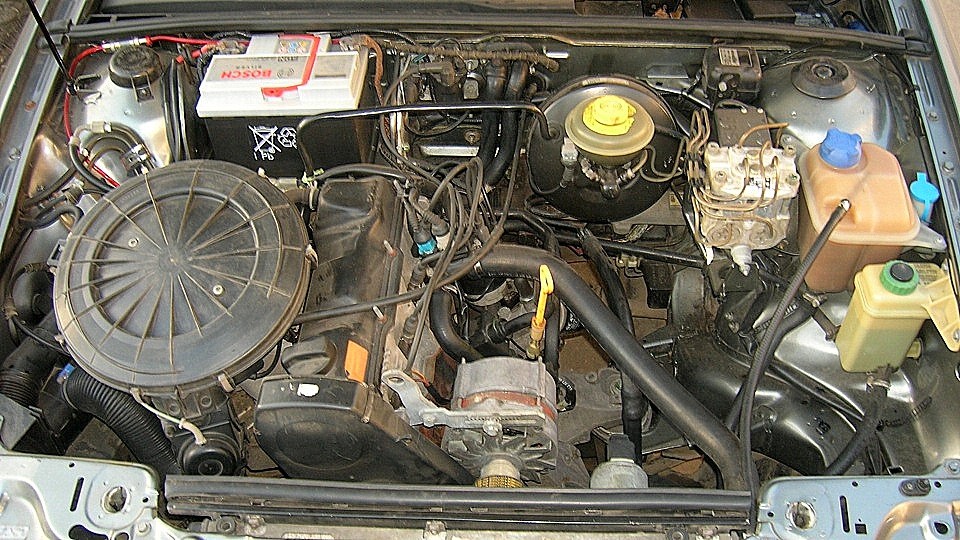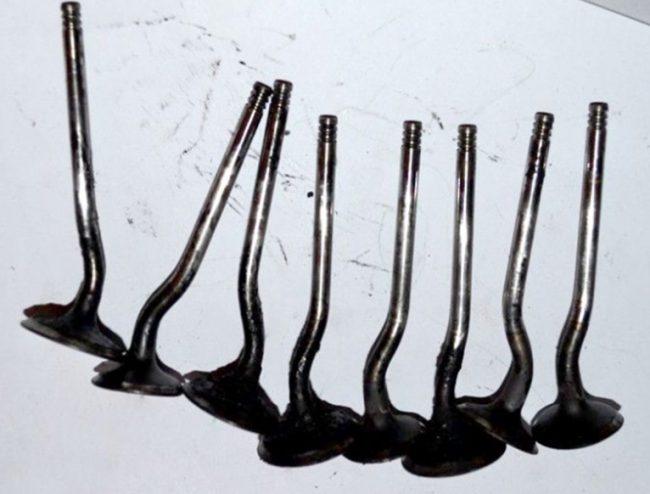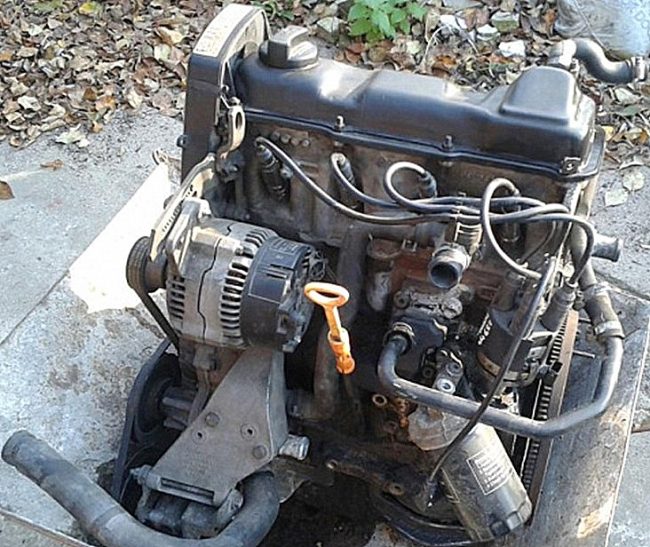
Audi ABT engine
Content
The power unit created for the Audi 80 entered the line of Volkswagen engines EA827-2,0 (2E, AAD, AAE, ABF, ABK, ACE, ADY, AGG).
Description
In 1991, VAG engineers developed and introduced the Audi ABT engine into production. It was intended for installation on the then popular Audi 80 model. The production of the unit continued until 1996 inclusive.

The analogue for the creation of ABT was the parallel-produced ABK. The main difference in motors lies in the fuel supply systems. In addition, ABT has a power of 25 liters. with less than analogue.
The Audi ABT engine is a 2,0-liter gasoline in-line four-cylinder aspirated engine with a capacity of 90 hp. with and a torque of 148 Nm.
Installed only on the Audi 80 model:
- Audi 80 sedan B4 /8C_/ (1991-1994);
- Audi 80 Avant B4 /8C_/ (1992-1996).
The cylinder block is not sleeved, cast iron. Inside, in addition to the crankshaft, an intermediate shaft is mounted, which transmits rotation to the oil pump and ignition distributor.
Aluminum pistons with three rings. Two upper compression, lower oil scraper. Temperature-controlled steel plates are installed in the bottoms of the pistons.
The crankshaft is located on five bearings.
Aluminum cylinder head, overhead camshaft (SOHC). Eight guides for valves equipped with hydraulic compensators are pressed into the body of the head.
The unit has a lightweight timing drive - a belt. When it breaks, the bending of the valves does not always happen, but it is possible.
Lubrication system without features. Three liter capacity. The recommended oil is 5W-30 approved by VW 501.01/00. The use of SAE 10W-30 and 10W-40 mineral oil is not permitted.
Unlike its counterpart, the engine has a Mono-Motronic fuel injection system. It is more advanced than Digifant used on ABK.

In general, ABT has satisfactory speed characteristics, but its high-torque performance is noted on the “bottoms”. In addition, the unit is ideal for installing gas equipment on it.
Technical specifications
| Manufacturer | Audi AG, Volkswagen Group |
|---|---|
| Release year | 1991 |
| Volume, cm³ | 1984 |
| Power, hp from | 90 |
| Power index, l. s/1 liter volume | 45 |
| Torque, Nm | 148 |
| Compression ratio | 8.9 |
| Cylinder block | cast iron |
| Number of cylinders | 4 |
| Cylinder head | aluminum |
| The working volume of the combustion chamber, cm³ | 55.73 |
| Fuel injection order | 1-3-4-2 |
| Cylinder diameter, mm | 82.5 |
| The piston stroke, mm | 92.8 |
| Timing drive | belt |
| Number of valves per cylinder | 2 (SOHC) |
| Turbocharging | no |
| Hydraulic compensators | Yes |
| Camshaft adjuster | no |
| Lubrication system capacity, l | 3 |
| Applied oil | 5W-30 |
| Oil consumption (calculated), l / 1000 km | to 1,0 |
| Fuel system | single injection |
| Fuel | gasoline AI-92 |
| Environmental standards | Euro 1 |
| Resource, outside. km | 400 |
| Location | longitudinal |
| Tuning (potential), l. With | 300 + * |
* safe increase to 96-98 liters. With
Reliability, weaknesses, maintainability
Reliability
The Audi car has won the love of motorists and is widely popular. Accordingly, the laurels of honor went to his engine. This attitude became possible due to the high quality of products, and hence reliability.
In the reviews about the internal combustion engine - only positive emotions. So, mgt (Veliky Novgorod) summarizes: “... an excellent engine, they are still talking about a millionaire!».
The engine reliability manufacturer pays close attention. For example, not every motorist knows about protecting the engine from overspeeding the crankshaft.
In practice, it looks like this - at very high speeds, interruptions in work begin to appear, the speed drops. Some take this behavior as a malfunction. In fact, the motor self-protection is triggered.
An interesting statement by Vikleo (Perm): “… ABT is a normal engine. The most delicious lotion - single injection WITH HEATING!!!! At first, I could not understand why it starts up so well at -30 and below, until I figured out that there is heating on the intake manifold. Electrical not to be killed».
Due to its high reliability, ABT has an impressive resource. With proper operation and timely maintenance, it easily nurses 500 thousand km.
In addition to the resource, the unit is famous for its good margin of safety. But this does not mean that it can be forced indefinitely.
"Evil" tuning will help squeeze more than 300 hp out of the engine. s, but at the same time it will reduce its resource to 30-40 thousand km. A simple chip tuning will give an increase of 6-8 liters. s, but against the general background, it is likely to become not very noticeable.
Thus, a large margin of safety plays its positive role not in increasing power, but in increasing the durability of the engine.
Weak spots
The Audi ABT engine, like its counterpart ABK, is devoid of characteristic weaknesses. But a long service life makes its own adjustments in this matter.
So, a lot of problems are caused by the Mono-Motronic fuel injection system. At the same time, some car owners have no complaints about it. For example, car enthusiast jr hildebrand from Kazan spoke on this topic as follows: “... injection system - single injection ... Never in 15 years they climbed there, everything works fine. Consumption on the highway is about 8l / 100km, in the city 11l / 100km».
The fuel system sometimes presents a number of surprises. Here it is necessary to take into account not only the age of the engine, but also the low quality of our fuels and lubricants, especially fuel.
The result is a rapid contamination of the elements of the system. First of all, the throttle valve and nozzles suffer. After flushing, the engine performance is restored.
Failures in the operation of the ignition system are not uncommon. As a rule, they are caused by limiting operational wear. Replacing the elements of the system that have exhausted their resource eliminates the problems that have arisen.
The timing belt requires special attention. It must be replaced after 60-70 thousand kilometers, despite the fact that the manufacturer recommends doing this operation after 90 thousand km. When the belt breaks, most often the valves do not bend, but it happens the other way around.

With long runs (more than 250 thousand km), an increased oil consumption (oil burner) appears in the engine. At the same time, the sound of hydraulic lifters increases. These phenomena indicate that the overhaul of the unit has approached a critical point.
But, if the engine was serviced in a timely manner and operated on high-quality fuels and lubricants, a mileage of 200-250 thousand km is not great. Therefore, these malfunctions do not threaten him for a long time.
Maintainability
The simplicity of the design and the cast-iron cylinder block allow you to carry out repair work on your own, without involving car services. An example is the statement of the car owner Docent51 (Murmansk): “... I have a B4 Avant with ABT, mileage 228 thousand km. The machine ate up the oil well, but after replacing the valve stem seals, it does not eat a drop!».
The cylinder block can be bored to two repair sizes. When this possibility runs out, some motorists make internal combustion engine sleeves. Thus, the unit is able to withstand many full-scale overhauls.
Equally important is the availability of spare parts for restoration. They can be purchased at any specialized store, in the most extreme case - at the "secondary" (disassembly).
The manufacturer recommends using only original components and parts for repairs. The quality of recovery depends on them. The fact is that for used spare parts, like for analogues, it is impossible to determine the residual resource.

Some motorists prefer to replace the engine with a contract one.
The price of a workable one (set it - went) lies in the range of 40-60 thousand rubles. Depending on the configuration, attachments can be found much cheaper - from 15 thousand rubles.

